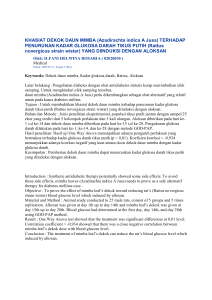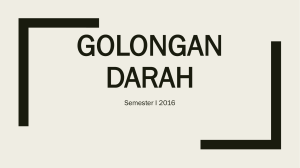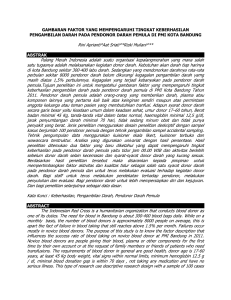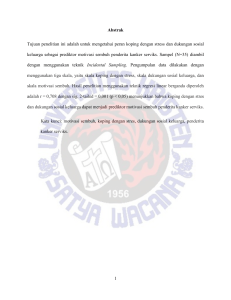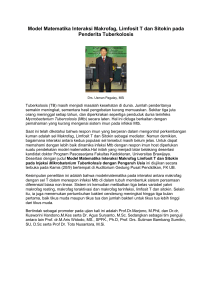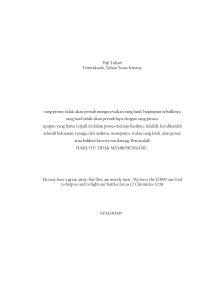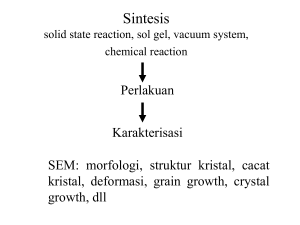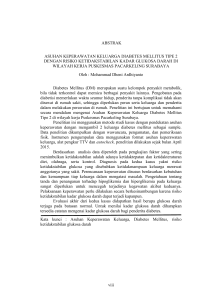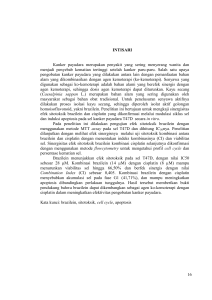Peran Uji Mikrobiologi
advertisement
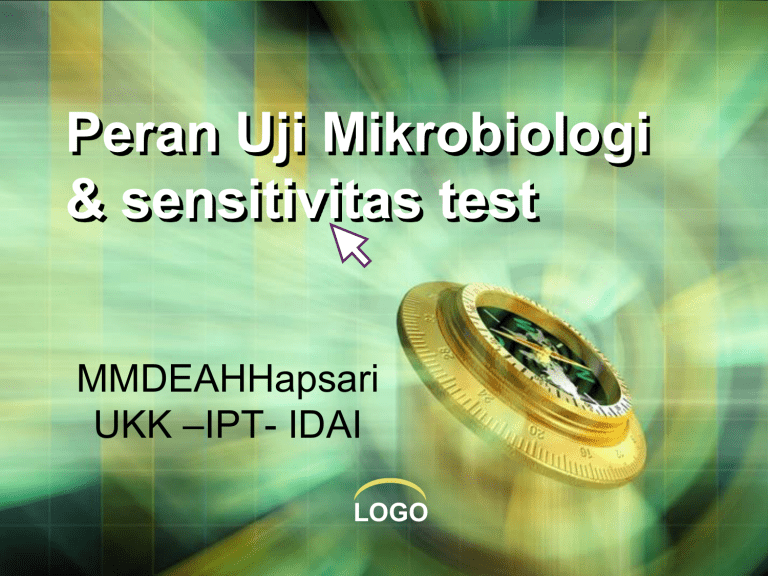
Peran Uji Mikrobiologi & sensitivitas test MMDEAHHapsari UKK –IPT- IDAI LOGO Kuntaman ,Loknas PPRA Mikroba dan manusia Sedikit mikroba yang patogen Banyak mikroba yang potensial untuk patogen Sebagian besar mikroba tidak patogen FAKTOR BIOLOGIS Flora normal (mayoritas bakteri) pada kulit dan saluran pencernaan mencegah kolonisasi bakteri patogenik dengan mengeluarkan substansi toksik atau dengan bersaing mendapatkan nutrien. Ada 1013 sel dan terdapat 1014 bakteri, yang mayoritas hidup di usus besar. Ada 103-104 mikroba per cm2 di kulit (Staphylococcus aureus, Staphylococcus epidermidis, Diphtheroid, Streptococci, Candida dll.). Berbagai macam bakteri hidup di hidung dan mulut Di lambung dan usus halus terdapat Lactobacilli Di usus halus terdapat 104 bakteri per gram dan di usus besar 1011 per gram, 95-99% di antaranya adalah anaerob. Di saluran kemih terdapat koloni berbagai bakteri dan difteroid. Setelah pubertas, terdapat koloni Lactobacillus aerophilus yang mengfermentasi glikogen untuk mempertahankan pH asam. Flora normal menciptakan kesesuaian ekologis dalam tubuh, dan menghasilkan baktoriosidin, defensin, protein kationik dan laktoferin yang merusak bakteri lain. Bagaimana mengetahui patogen tertentu dapat menyebabkan penyakit tertentu? Diagnosis dan terapi infeksi tidak tergantung dari kuman tetapi juga melihat hasil laboratorium yang lain serta gejala klinis pasien Gejala Klinis mis. septicaemia, endocarditis, osteomyelitis meningitis, UTI, pneumonia pharyngitis Kondisi pasien Kuman patogen didapat dari kultur Alur Pemeriksaan Mikrobiologi Contents 1 Handling specimen 2 Diagnosis Laboratorium Infeksi 3 Peta medan kuman 44 Pemilihan AB berdasarkan sensitivitas test 5 Mekmnisme Resistensi Diagnosis of Bacterial Infection Patient Clinical diagnosis Non-microbiological investigations Radiology Haematology Biochemistry Sample Take the correct specimen Take the specimen correctly Label & package the specimen up correctly Appropriate transport & storage of specimen The specimen must be collected with a minimum of contamination as close to site of infection as possible Specimen Urine Culture Blood Culture, bacterial, mycobacterial, fungal Source of Contamination All non surgical samples become contaminated with urogenital flora during collection. Contaminating bacteria will replicate if specimen is not quickly transferred to a preservative tube or stored (4°C). Improper cleaning of skin or catheter prior to drawing specimen. Transfer from SPS tube to blood culture vial. Collection from catheter. Storage and Transport Transfer urine to a Urine Preservative tube within 10 minutes of collection (good for 48 hrs. at ambient temp. Less optimal: store/transport urines at 4° C for up to 24 hrs. Ambient. Must be incubated in automated system within 12 hours. Solution/Monitor Patients must be instructed to properly cleanse the peri-urethral genital skin area prior to collection of the midstream portion of the urine stream in order to get an accurate urine culture result. Use of urine preservative tubes. Ongoing education program. Monitoring contamination rates. Limit use SPS tubes. Do not draw from catheter unless specifically requested (protocol; discard 5X cath. volume); then one culture set from catheter and one from peripheral. Education Prompt feedback to individuals or sites who collected urine for culture. Urine preservative tubes should be used when appropriate. Timely feedback to individuals who collected specimen. Blood Culture Two sets of blood cultures should be drawn. Number of sets positive correlates with true sepsis (except for coagulase negative Staph?) (Clin Microbiol. Rev 19:788802, 2006) Catheter drawn blood cultures Catheter drawn blood cultures are equally likely to be truly positive (associated with sepsis), but more likely to be colonized (J Clin Microbiol 38:3393, 2001.) • One drawn through catheter and other though vein PPV 0f 96% • Both drawn from catheter PPV 0f 50% • Both drawn through vein PPV of 98% Study of positive coagulase negative Staphylococcus cultures and sepsis (Clin Infect Dis. 39:333, 2004.) A specimen must be collected at the optimal time(s) in order to recover the pathogen(s) of interest Specimen Urine Optimal Time First morning specimen preferred. Blood Culture Collect prior to administration of antibiotics. Collect 2-3 sets of blood cultures from different sites. If suspect bacterial endocarditis and initial cultures are negative at 48 hours then collect 2-3 additional cultures from different sites. Suspected bacteremia or fungemia with persistently negative blood cultures AFB Culture GC/Chlamydia, urine Three consecutive specimens collected 8-24 hours apart, with at least one being an early AM specimen First voided urine of day. First stream of urine optimal. Less sensitive: Patient should not have urinated for at least 1 hour. Comments Or not have urinated in several hours Interpretation of one positive culture problematic, especially if isolate is coagulase negative Staphylococcus. Consider laternative blood culture methods dsigned to enhance recovery of mycobacteria, fungi, and other rare and fastidious microorganisms Sputum not saliva Not midstream urine. Place sample in transport tube per manufacturer’s instructions Do not use NAT methods as “proof of cure”. Lingering DNA may still be present. A specimen must be collected at the optimal time(s) in order to recover the pathogen(s) of interest (cont) Specimen Ova and Parasites Stool Cultures Optimal Time Wait 10 days if barium or oil present. For multiple samples, collect every other day. Recommend 2 samples on consecutive days. Prior to 3 days post admission. Blood Parasites Collect during a febrile episode or every 6 hours for a 24 hour period. Viral Culture Collect as soon after onset of symptoms as possible. Comments Place stool in preservative (10% formalin, PVA, SAF, Ecofix) within one hour of collection. Instruct patient. Place in enteric preservative (CaryBlair) immediately. Stool specimens that are obtained 3 days after admission are not usually helpful for the diagnosis of hospital acquired diarrhea Submit finger stick Thick & Thin slides or peripheral blood in an EDTA tube within 24 hours. Store at ambient temperature. The first 3 days is best. A sufficient quantity of the specimen must be obtained to perform the requested tests Culture Blood Culture Minimum Requirements 10 ml of aerobic; 10 ml for anaerobic bottle Comment One swab for multiple cultures CSF Culture A separate swab(s) for each culture Sensitivity of a blood culture is directly related to the volume of blood submitted. Two blood culture sets (10 mL in both aerobic and anerobic bottles) before administration of antibiotics is 98% sensitive (J. Clin. Microbiol. 1998 36: 657-661). Enough material must be submitted for gram stain, if required. 2 mL from tube 2,3, or 4 Submit most turbid tube. At least 0.5 mL of CSF is required for cytospin gram stain. Surgical and Shared Specimens Anaerobic Cultures See chart Cooperation with other departments (laboratory and non laboratory) is key. See Table Blood Cultures Volume of blood drawn is the single most important factor influencing sensitivity. A single set for an adult blood culture consists of one aerobic and one anaerobic bottle. Optimally 10 mL of blood should be inoculated into each bottle. Volume of blood for a pediatric culture can be related to the infants weight Solitary blood cultures should be less than 5% (Arch Pathol Lab Med. 2001 125:1290-1294) If only enough blood can be drawn for one bottle, inoculate the aerobic bottle. 644 positive blood cultures, 59.8% from both bottles, 29.8% from aerobic bottle only and 10.4% from anaerobic bottle only (J Infect Chemother 9:227, 2003). Pediatric Blood Cultures - Volume Recommended Pediatric Blood Culture Volumes By Patient Weight Weight Weight Minimum One Two Adult (KG) of (LB) of Volume Pediatric Bottles Patient Patient (mL) Bottle (aerobic and anaerobic) <1.0 Kg 2.2 Lb. 1.0 mL Yes No 1.5-3.9 Kg 2.3-8.6 Lb. 1.5 mL Yes No 4.0-13.9 Kg 8.7-30.6 Lb 3.0 mL Yes No 14.0-24.9 30.7-54.9 10.0 mL No Yes (5 mL in Kg Lb each) >25.0 Kg >55 Lb. 20.0 Ml No Yes (10 mL in each) Collect all microbiology test samples prior to the institution of antibiotics Specimen Blood Culture Hair, skin and nails Fungal Culture Urine Culture Comments Collect two sets at same time from different sets. DO NOT collect both sets from the same site (assessment for contamination) Collect before antifungal therapy or discontinue treatment for at least 5 days. Antibiotics may cause a transient decrease in bacterial concentration resulting in a false negative report Blood Cultures - Volume The magnitude of bacteremia may be low (<1cfu/ml) Higher volumes have higher yield Increase Volume Increase Yield 10 ml 20 ml 30% 40% 20 ml 30 ml 10% 15% Urine - General Collection method must avoid contamination Clean catch, midstream voided Catheterized urine Suprapubic aspiration Cultures performed quantitatively Less than 10,000 per ml suggest contamination Pengambilan spesimen yang benar Urin – mid-stream Hindari kontaminasi dengan flora perineal LCS Cegah kontaminasi Cegah perdarahan Kultur darah Cegah kontaminasi dengan kuman di permukaan kulit Pengiriman spesimen ke laboratorium Keterlambatan pengiriman akan menyebabkan keterlambatan diagnosis dan terapi Pathogen mati Pertumbuhan kontaminan Kultur darah harus segera masuk inkubator Bukan almari es ( refrigerator) LCS segera dikirim ke Lab Faktor –faktor yang berpengaruh atas hasil kultur darah Sampel yang slalah Sputum – didapat saliva Terlambat kirim LCS Pertumbuhan kontaminan Misal kultur darah Pasien sudah mendapatkan antibiotika Handling specimen Lab Mikrobiologi Darah Urin Turn Around Time Pus Tinja Sputum Cara pengambilan, penyimpanan dan pengiriman bahan Petunjuk Umum Pemeriksaan diambil sebelum diberikan antibiotik Bahasn pemeriksaan diambil saat & lokasi yang tepat( untuk dapat kuman) Tindakan aseptik Jumlah cukup Formulir diisi lengkap(riwayat penyakit, pengobatan,diagnosis Pelabelan yang jelas Petunjuk Khusus Air seni –penampungan pagi hari-sterilmidstream/ katetersegera kirim.( Urin diambil < 3 hari MRS) Darah : diambil sesuai perjalan penyakit Dengan media “bactec” Ukuran sesuai dengan aturan Lanjt..... Tinja Pengambilan pada pagi hari atau tinja yang baru Hapusan rektum kurang dianjurkan Jumlah 10 gramn Segera kirim LCS Pengambilan dengan pungsi Pengiriman segera mungkin Culture diagnostic of typhoid 100 90 % patients with pos culture 80 70 bloods 60 stool 50 40 30 urine 20 10 0 1 2 3 4 5 weeks 6 7 8 Contents 1 Handling specimen 2 Diagnosis Laboratorium Infeksi 3 Peta medan kuman 44 Pemilihan AB berdasarkan sensitivitas test 5 Mekanisme Resistensi Laboratorium Mikrobiologi Pemeriksaan Kultur Darah Contents 1 Handling specimen 2 Diagnosis Laboratorium Infeksi 3 Peta medan kuman 44 Pemilihan AB berdasarkan sensitivitas test 5 Mekanisme Resistens Hasil Peta Kuman – sensitivitas PICU-NICU - darah (Jan-Jun 2009)RSDK Chl Gen Cip Ctx Caz DKB FOS MEM MFX SXT Enterobacter.aerog enes 92 7 84 26 34 33 80 100 76 64 Eschericia coli 50 25 87 37 50 87 100 87 50 Pseudomonas aeroginosa 81 6 68 0 37 0 87 25 50 Staphylococcus epidemidis 83 33 33 33 50 100 50 33 100 80 Ruang Anak VAN 100 Contents 1 Handling specimen 2 Diagnosis Laboratorium Infeksi 3 Peta medan kuman 44 Pemilihan AB berdasarkan sensitivitas test 5 Mekanisme Resistensi Pengamatan Hasil Pemeriksaan Mikrobiologi Pengamatan Hasil Sebelum Terapi Empirik Sesudah Terapi Definitif Spektrum luas De-escalating Data epidemiologi Narrow sp Pengamatan aman oost 12 Steps to Prevent Antimicrobial Resistance: Hospitalized Adults Use Antimicrobials Wisely Treat infection, not contamination Fact: A major cause of antimicrobial overuse is “treatment” of contaminated cultures. Actions: use proper antisepsis for blood & other cultures culture the blood, not the skin or catheter hub use proper methods to obtain & process all cultures Link to: CAP standards for specimen collection and management 12 Steps to Prevent Antimicrobial Resistance: Hospitalized Adults Use Antimicrobials Wisely Treat infection, not colonization Fact: A major cause of antimicrobial overuse is treatment of colonization. Actions: treat bacteremia, not the catheter tip or hub treat pneumonia, not the tracheal aspirate treat urinary tract infection, not the indwelling catheter Link to: IDSA guideline for evaluating fever in critically ill adults Follow Established Guidelines Consult Specialist Follow Guidelines Use Local Data Stop Antimicrobial Treatment Know your antibiogram Know your formulary Know your patient population When infection is not diagnosed When infection is unlikely Hasil Kultur Darah Ruang Anak RSDK Kuman Jumlah Prosentase Candida albicans 1 0.45 % Enterobacter aerogenes 86 38.7 % Escherichia coli 14 6.3 % Pseudomonas aeruginosa 26 11.7 % 4 1.8 % Staphylococcus aureus 28 12.6 % Staphylococcus epidermidis 61 27.4 % Streptococcus pneumoniae 2 0.9 % Salmonella typhi Perjalanan anak dengan sepsis 39.5 Pasien sepsis dengan demam selama 10 hari. 39 Esch.coli ( urin) 38.5 Suhu 38 Pseudo.aero ( darah ) Kleb.pnem ( darah ) 37.5 Series1 37 36.5 L : 19.300 L :21.000 L : 19.000 L : 8.300 36 35.5 1 2 3 4 Ampi-sulbactam 5 6 7 8 9 10 11 Hari perawatan 12 Amikasin 13 14 15 16 17 18 Kultur Darah : Klebsiella pneumonia Kultur Darah 28/8/2010 Hasil Kuman: Klebsiella Pneumonia Sensitif: Amikacin, cefepim. Imipenem, meropenem, sulbactam cefoperazon Resisten: Ampicilin, ceftazidim, kotrimoksasol, gentamycin, moxifloxacin Kultur Urin : Escherichia Coli Kultur Darah 4/9/2010 Hasil Kuman: Escherichia Coli, > 100.000 Sensitif: Cefepim. Gentamycin, Imipenem, meropenem, fosfomycin Resisten: Amikacin, Ampicilin, Ampicilin sulbactam, ceftazidim, kotrimoksasol, moxifloxacin Kultur Darah : Pseudomonas aeroginosa Kultur Darah 7/9/2010 Hasil Kuman: Pseudomonas aeruginosa Sensitif: Kotrimoksasol, meropenem Resisten: Amikacin, Ampicilin, Cefepim, gentamicin, moxifloxacin, fosfomycin Pasien DSS mengalami : -Sepsis -VAP + Gagal Nafas -Perdarahan Sembuh Perawatan selama 2 bulan Invitro : Chloramphenicol = S Invivio : Pseudomonas tidak bisa dengan Chloramphenicol Pasien dengan diare kronis Hasil Kultur feses : Escherichia coli EPEC (+), berarti memang didapatkan infeksi di saluran cerna Contents 1 Handling specimen 2 Diagnosis Laboratorium Infeksi 3 Peta medan kuman 44 Pemilihan AB berdasarkan sensitivitas test 5 Mekanisme Resistensi Mechanisms of antimicrobial resistance Antimicrobial agents are catagorized according to their principle mechanism of action 1. Interference with cell wall synthesis ( lactams, Glycopeptide agents) 2. Inhibition of protein synthesis (macrolide, tetracycline) 3. Interference with nucleic acid synthesis (fluoroquinolones, rifampin) 4. Inhibition of a metabolic pathway (trimetopim sulfamethoxazole) 5. Disruption of bacterial membrane structure (polymixin) Tenover FC. Am J Med 2006;119(6):S3-S10 48 1 3 4 2 5 Table . Pediatric bacterial pathogens, mechanisms of resist …mechanisms of antimicrobial resistance Organism Mech of resist clinical implications ________________________________________________________ Str pneumoniae alteration of PBP alteration in the ribosomal binding site of antibiotics efflux pump to expel an antibiotics from the cyoplasm relative resistant to -lactam agents (pen cillin, cephalosp) resistance to macrolide relative resist to macro lide Pong AL. Pediatr Clin N Am 2005;52:869-94 50 …mechanisms of antimicrobial resistance Pediatric bacterial pathogens, mechanisms of resist Organism Mech of resist clinical implications ________________________________________________________ S. Aureus alteration in the binding site of a specific transpeptidase (mecA) alteration at ribosomal binding site efflux pump to expel an antib from the cyopl resistant to all -lactams resistance to macrolides and clindamycin relative resist to macro lide Pong AL. Pediatr Clin N Am 2005;52:869-94 51 …mechanisms of antimicrobial resistance Pediatric bacterial pathogens, mechanisms of resist Organism Mech of resist clinical implications ________________________________________________________ Escherichia coli, Klebsiella Enterobacter, Seratia, other Enterobacteriaceae -lactamases with activity extended beyond ampic (ESBL) chromosomal -lactamases that are deregulated and hyperproduced (ampC) ceftazidim resistant to cefotaxim, ceftriaxone, ceftazidim resistant to cefotaxim, ceftriaxone ceftazidim Pong AL. Pediatr Clin N Am 2005;52:869-94 52 …mechanisms of antimicrobial resistance Pediatric bacterial pathogens, mechanisms of resist Organism Mech of resist clinical implications ________________________________________________________ Pseudomonas aerug multipel -lactamases each with activity against different -lactam antibiotics cell wall porin protein deficient bacteria multiple efflux pumps to expel antib from the cytoplasm resistant to cefotaxime ceftriaxone ceftazidim carbapenem resist resistance to -lactam fluoroquinolones Pong AL. Pediatr Clin N Am 2005;52:869-94 53 MAJOR ANTIBIOTIC RESISTANCE MECHANISMS Produce antibiotic inactivating enzymes Reduce intracellular antibiotic concentration Alter antibiotic target site Eliminate antibiotic target site 54 Table Major Antibiotic Resistance Mechanisms Resistance Mechanism Specific examples Antibiotic's effected Produce antibiotic inactivating enzymes β-lactamase, extended spectrum β-lactamases β-lactamase Adenyl, phosphoryl or acetyl transferases Aminoglycoside Reduce intracelluler concentration of the antibiotic Efflux pump Macrolides, tetracyclines, fluoroquinolones Reduce outer membrane permeability Penicillins, macrolides, fluoroquinolones Altered penicillins binding proteins β-lactamases Change peptidoglycans termini Glycopeptides Mutations in gyrases or topoisomerase genes tRNA methylases Fluoroquinolone Macrolides Encode an alternative penicillin binding protein Methicillin Produce less enzyme or an alternative enzyme Trimethoprim, Sulphonamides Alter the antibiotic target site Eliminate the antibiotic target site 55 Mechanisms of Antibiotic Resistance • • • • Enzymatic destruction of drug Prevention of penetration of drug Alteration of drug's target site Rapid ejection of the drug Antibiotic Resistance Figure 20.20 Proses Resistensi bakteria proses biologi alamiah Mutation Gene exchange Selection Transmission Campaign to Prevent Antimicrobial Resistance in Healthcare Settings Emergence of Antimicrobial Resistance Susceptible Bacteria Resistant Bacteria Resistance Gene Transfer New Resistant Bacteria Mutation R Gene exchange Konjugasi Transduksi Gene exchange R Gene exchange R R R Campaign to Prevent Antimicrobial Resistance in Healthcare Settings Selection for antimicrobial-resistant Strains Resistant Strains Rare Antimicrobial Exposure Resistant Strains Dominant Selection Transmission • • • • • • • Air Droplets Contact Water Food Blood Vectors Antibiotic Selection for Resistant Bacteria Rangkuman Pemeriksaan mikrobiologi khususnya biakan dan sensitifitas test sangat berperan dalam menegakkan suatu penyakit infeksi Handling dan koleksi spesimen haruslah mengikuti kaidah yang sudah ditentukan Pelaporan peta medan kuman disetiap RS dengan rutin sangat mendukung dalam pengelolaan pasien infeksi di RS tersebut Penentuan pemberian antibiotik berdasarkan hasil biakan haruslah hati-hati, mengingat kadang ada perbedaan antara invivo dan invitro www.themegallery.com LOGO


